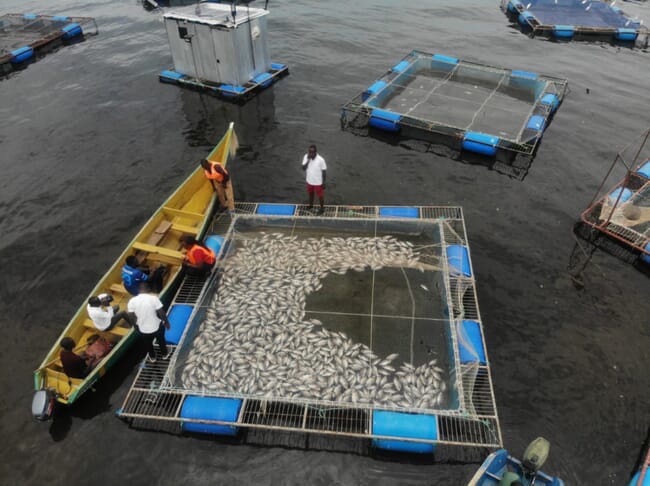
© Peter Changtoek
The farmers are yet to determine the cause of the fish deaths, though there have been various explanations, such as upwelling, posed by various experts.
Adams Gina, a fish farmer in Mulukoba Beach in Budalangi, Busia County, says that he has incurred losses amounting to Ksh5.6 million (approximately $44,000) after his fish died.
“I have five cages, and four of them have been affected. One cage holds 8,000 fish,” says the farmer, who had harvested from only one cage by the time the incident occurred. He was expecting to harvest from the four affected cages during November and December, when the demand for fish is high.
This is not the first mass fish mortality event to occur in Lake Victoria. Thousands of fish died in 2022 and 2023 when some parts of the lake were severely affected, including Rudacho Beach.
“In the area that the county allocated us, a feasibility study had been done, and found that upwelling cannot easily take place,” Gina says.
Yufnalis Okubo is another fish farmer who lost fish in all of his three cages. He had stocked 15,000 fingerlings in each of two 5 by 10 metre cages and, in another 5 by 5 cage, he had stocked 8,000 fingerlings. In total he had 38,000 fish, which were about six months old.
“It’s a great loss. The fish were to be harvested in December when we normally have a very high demand. One kg of fish goes for Ksh350 ($2.7) and if that was to grow to full capacity, I would have harvested 38 tonnes, which would fetch a gross of Ksh13.8 million ($106,977), at full growth. But, because not all the stocks grow at the same level, we always get around two-thirds or 50 percent, also accounting for mortality. The gross estimate would have been about Ksh7 million ($54,264),” he says.
Okubo believes the cause of the mass mortality event is a natural phenomenon called upwelling, which occurs annually but with different forces and severity.
“Last year Mulukoba Beach was not affected as the upwelling did not have a lot of force and was not as severe as this year. We can do better with frequent aquaculture support,” Okubo says.
Joakim Omollo Oijambo, chairman of Mulukoba Beach, which is in Port Victoria, says that the mass fish deaths started occurring a few days ago and that all cages have been affected.
“They have all died. We have lost almost 250 tonnes,” he reveals.
Edward Obuyu, another fish farmer who incurred losses due to the death of his fish, appealed to Busia County Government to intervene.
The Cabinet Secretary for Mining, Blue Economy and Maritime Affairs, Ali Hassan Joho, held a joint press briefing with Dr Paul Otuoma, Busia County Governor, and announced that they have compensated the affected farmers by giving them Ksh7 million ($54,264) to facilitate the buying of fingerlings, plus an additional Ksh2.5 million ($19,380) to buy fish feeds.




